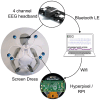Brain-computer-interface-driven artistic expression: real-time cognitive visualization in the pangolin scales animatronic dress and screen dress
- PMID: 40115887
- PMCID: PMC11925262
- DOI: 10.3389/fnhum.2025.1516776
Brain-computer-interface-driven artistic expression: real-time cognitive visualization in the pangolin scales animatronic dress and screen dress
Abstract
This paper explores the intersection of brain-computer interfaces (BCIs) and artistic expression, showcasing two innovative projects that merge neuroscience with interactive wearable technology. BCIs, traditionally applied in clinical settings, have expanded into creative domains, enabling real-time monitoring and representation of cognitive states. The first project showcases a low-channel BCI Screen Dress, utilizing a 4-channel electroencephalography (EEG) headband to extract an engagement biomarker. The engagement is visualized through animated eyes on small screens embedded in a 3D-printed dress, which dynamically responds to the wearer's cognitive state. This system offers an accessible approach to cognitive visualization, leveraging real-time engagement estimation and demonstrating the effectiveness of low-channel BCIs in artistic applications. In contrast, the second project involves an ultra-high-density EEG (uHD EEG) system integrated into an animatronic dress inspired by pangolin scales. The uHD EEG system drives physical movements and lighting, visually and kinetically expressing different EEG frequency bands. Results show that both projects have successfully transformed brain signals into interactive, wearable art, offering a multisensory experience for both wearers and audiences. These projects highlight the vast potential of BCIs beyond traditional clinical applications, extending into fields such as entertainment, fashion, and education. These innovative wearable systems underscore the ability of BCIs to expand the boundaries of creative expression, turning the wearer's cognitive processes into art. The combination of neuroscience and fashion tech, from simplified EEG headsets to uHD EEG systems, demonstrates the scalability of BCI applications in artistic domains.
Keywords: 3D-print; BCI; animatronic; art; engagement; fashion-tech; uHD EEG.
Copyright © 2025 Schreiner, Wipprecht, Olyanasab, Sieghartsleitner, Pretl and Guger.
Conflict of interest statement
LS, AO and SS are employed at g.tec Medical Engineering GmbH. CG is the CEO of g.tec Medical Engineering GmbH. g.tec Medical Engineering GmbH had the following involvement in the study: providing the technology used for data acquisition and processing. The remaining authors declare that the research was conducted in the absence of any commercial or financial relationships that could be construed as a potential conflict of interest.
Figures












Similar articles
-
A Magnetoencephalographic/Encephalographic (MEG/EEG) Brain-Computer Interface Driver for Interactive iOS Mobile Videogame Applications Utilizing the Hadoop Ecosystem, MongoDB, and Cassandra NoSQL Databases.Diseases. 2018 Sep 28;6(4):89. doi: 10.3390/diseases6040089. Diseases. 2018. PMID: 30274210 Free PMC article.
-
Recent Progress in Wearable Brain-Computer Interface (BCI) Devices Based on Electroencephalogram (EEG) for Medical Applications: A Review.Health Data Sci. 2023 Dec 19;3:0096. doi: 10.34133/hds.0096. eCollection 2023. Health Data Sci. 2023. PMID: 38487198 Free PMC article. Review.
-
Recording human electrocorticographic (ECoG) signals for neuroscientific research and real-time functional cortical mapping.J Vis Exp. 2012 Jun 26;(64):3993. doi: 10.3791/3993. J Vis Exp. 2012. PMID: 22782131 Free PMC article.
-
Design and verification of a wearable wireless 64-channel high-resolution EEG acquisition system with wi-fi transmission.Med Biol Eng Comput. 2023 Nov;61(11):3003-3019. doi: 10.1007/s11517-023-02879-y. Epub 2023 Aug 11. Med Biol Eng Comput. 2023. PMID: 37563528
-
Brain-computer interfaces: Definitions and principles.Handb Clin Neurol. 2020;168:15-23. doi: 10.1016/B978-0-444-63934-9.00002-0. Handb Clin Neurol. 2020. PMID: 32164849 Review.
References
-
- Abhang P. A., Gawali B. W., Mehrotra S. C. (2016). “Chapter 2 - technological basics of EEG recording and operation of apparatus” in Introduction to EEG- and speech-based emotion recognition. eds. Abhang P. A., Gawali B. W., Mehrotra S. C. (Academic Press; ), 19–50.
-
- Alfano V. (2019). Brain-computer interfaces and art: toward a theoretical framework. IJHAC 13, 182–195. doi: 10.3366/ijhac.2019.0235 - DOI
-
- Andujar M., Crawford C. S., Nijholt A., Jackson F., Gilbert J. E. (2015). Artistic brain-computer interfaces: the expression and stimulation of the user’s affective state. Brain-Comput. Interfaces 2, 60–69. doi: 10.1080/2326263X.2015.1104613 - DOI
LinkOut - more resources
Full Text Sources

